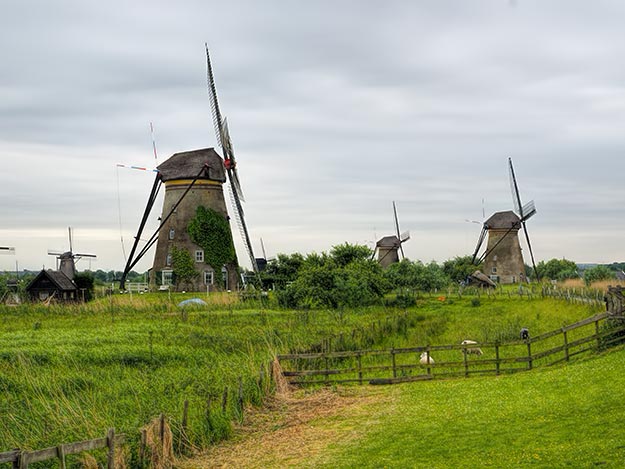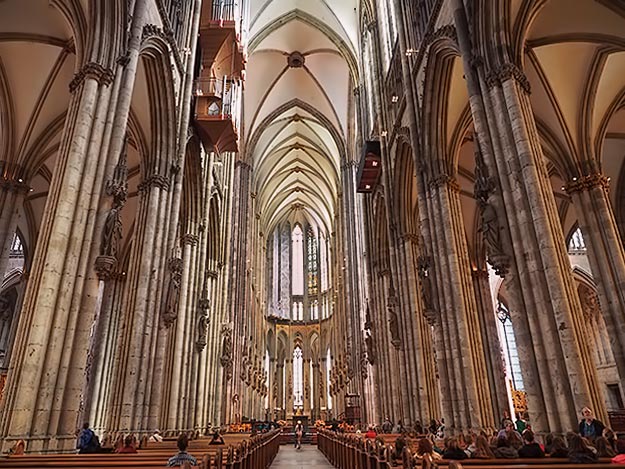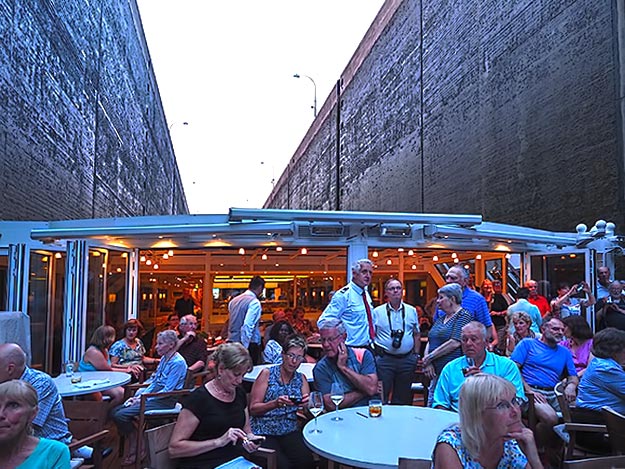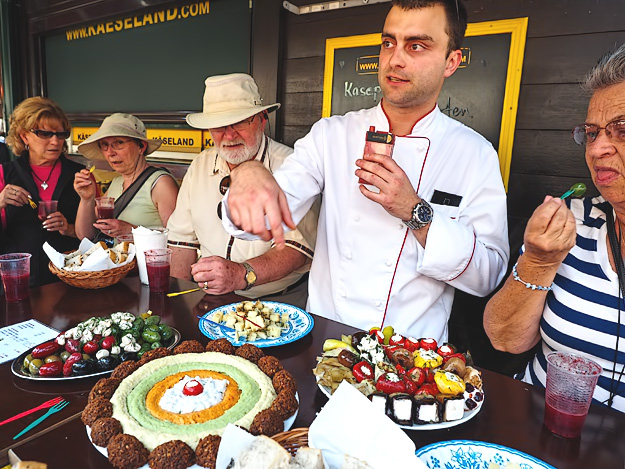The English historian, Edward Gibbon, once remarked that, “According to the law of custom, and perhaps of reason, foreign travel completes the education of an English gentleman.” Gibbon might well be considered an authority on the issue. In 1763, he embarked on a tour of continental Europe. A year later, while sitting amid the ruins of Rome, he conceived the idea for a book which later became The History of the Decline and Fall of the Roman Empire: 1776–1788. Gibbon was following in the footsteps of aristocratic young European men, for whom education was not complete without a Grand Tour of the capitols and cultural centers of Europe. Though the Grand Tour ceased to be an element of the educational landscape in the mid-1800’s, the tradition is still alive and well, as I discovered on my recent Viking River Grand European Tour.

My cruise began at the waterfront in Amsterdam, where Viking Skadi was docked. We sailed just before midnight. Though I missed out on seeing the tulip fields of the Netherlands, I was excited that our first stop would be Kinderdijk, the largest remaining collection of windmills in Holland. By morning, we were anchored on the shores of the Lek River, looking down upon a landscape where 19 historic windmills stood more than 20 feet below water level. It was easy to imagine that this area had once been an uninhabitable swamp. The ingenious Dutch, however, made these low-lying lands safe for human habitation through the use of windmills.

Today, water levels in Holland are controlled by high-tech pumping stations and sluices, but the UNESCO World Heritage Site at Kinderdijk provides a window to the past, demonstrating how the cogs, rods, rotating sails, shafts, scoop wheels, and screws were made by hand, as well as documenting the history of the millers who were responsible for the maintenance and operation of the mills. After a brief visit to the authentic workshop, where we learned the language of the sails (a diagonal “X” means the mill will not be used for a long time, a “plus sign” means a short rest, while more intricate sail positions indicate joy or grief), I climbed to the top of a working windmill that has been preserved in its original state, marveling that the tiny interior had been home to a miller, his wife, and their 13 children as recently as 1950.

By mid-afternoon we were back on board, sailing through the day and night toward our second country, Germany. When I awoke, we were docking in Cologne, just upstream from the famous Cathedral. With time to kill before Sunday worship services were over, I joined Viking’s included walking tour, then, rather than return to the ship for lunch, I stayed in town and waited for the Cathedral to open to the public. It was, perhaps, one of the best decisions I made during the cruise. I have seen many places of worship in my travels, but few rival the beauty and sheer magnificence of the Cologne Cathedral.

The following morning we sailed into the Middle Rhine. Here, vineyards carpeted the surrounding hills, making near-vertical descents to the banks of the river. Under brilliant blue skies, I rushed from side to side on the upper deck, shooting photos of myriad castles and fortresses that crowned the highest elevations or squatted on islands in the river. Historically, these lands had been carved up among noblemen, who made a fortune in tolls collected from passing ships.

Today the Rhine remains an important waterway, a fact that was driven home as we entered the flatter landscape of the Upper Rhine, where castles had been replaced by chemical and industrial plants. The further upstream we sailed, the more barges and tankers we passed, loaded with some of the 800 million tonnes of cargo that is transported on the river each year. Fortunately, we left much the commercial traffic behind at Mainz, where we veered off onto the Main River (pronounced “mine”), bound for Bavaria.

The next six days were a whirlwind of magical towns: Miltenberg, Rothenburg ob der Tauber, Wurzburg, Bamberg, Nuremberg, Regensburg, and Passau, with their impeccable half-timbered houses, cobblestone streets, and picture-perfect town squares. And the waterway changed once again. Just before Bamberg, we left the Main River and turned onto the Rhine-Main-Danube canal, which connects the North Sea and Atlantic Ocean to the Black Sea, making our voyage possible.

We were climbing at this point, making our way through 69 locks of ever increasing heights, until we reached the European Watershed, where we entered the tallest lock on the journey. Despite the early hour (3 a.m.), I ventured out onto the deck in a pounding rain to witness this 85-foot high concrete monolith that dwarfed our ship. My pulse beat in my temples and I could hear my blood rushing through my veins. I had visions of The Poseidon Adventure. What would happen if the gates failed and a wall of water came crashing down on us? I retreated to my Stateroom and watched the lock fill on the closed circuit TV, breathing a sigh of relief when the gates opened and we sailed out the other side. From that point, it was all downhill, and each subsequent lock was shallower, until we reached the Danube at Regensburg.

After a brief stop in Passau, we left Germany and entered the pretty Wachau Valley in Austria, a 25-mile stretch of the Danube between the towns of Melk and Krems. Over eons, the river has carved itself nearly 2,300 feet deep into the Bohemian Massif, leaving a landscape of sun-soaked, rolling hills that are perfectly suited for vineyards and apricot orchards. Following a visit to the 900-year old Baroque Melk Abbey, our ship continued to Krems.

Though Krems has been in existence for more than a thousand years and was once as large as Vienna, today it is best known as the primary producer of Marillenschnaps, an apricot brandy. I walked the mile or so to Steiner Tor, the 15th century city gate that still functions as the main entrance to the historic center, and wandered around until it was time to return to the ship for Viking’s Austrian-themed dinner. Amid a mountain of meat dishes, I found few vegetarian selections, but seeing the staff decked out in lederhosen and drindl skirts more than made up for the lack of vegetables.

Despite having partied into the wee hours, my eyes flew open at first light the next morning. We were in Vienna! And with only one day to discover this vibrant city, I intended to make the most of every moment. The included walking tour was a good start, orienting me to the city and providing a quick introduction to the most important sights, but afterward I had to choose how best to use my free time. I could have rushed through any one of a dozen museums, toured the Schonbrunn Palace, visited the interior of St. Stephan’s Cathedral, watched the Lippizaner Stallions work out, or just hung around the imposing palaces and grand old residences on the Ringstrasse, but in the end, my stomach won out. I ducked into the Sacher Hotel Cafe and ordered a slice of their world famous Sacher Torte, a chocolate cake with apricot filling.

With little time to spare, I hopped on the Metro and met Chef Jan back at the ship, just in time to join his tour of Naschmarkt, Vienna’s most popular market. Our group gathered around a table as the owners of shops began piling on the sample trays. Goat-cheese stuffed cherry peppers. Mountains of cubed artisan cheese. Fresh-baked olive bread. Marinated mushrooms and artichokes. Multi-flavored hummus surrounded by a ring of falafel balls. Olives, fresh cherries, and sliced dragon fruit. The food just never stopped coming.

If the Austrian-themed night on board had left me a little hungry, this feast had me waddling back to the ship like a beached whale. I wanted to fall back onto my bed and not move for 12 hours, but I had signed up to attend a Mozart and Strauss concert that evening, so I changed into my best clothes and put on a brave, if bloated face. In a city renowned for its music, I should have known the concert would be spectacular. I practically floated back to the ship.
We were nearing the end of our cruise, but there were still two more countries to visit. In Bratislava, capital of Slovakia, I opted to visit a local home in a nearby rural village. Our conversation soon turned to what life had been like under Communism, and how things had changed since the breakup of the Soviet Union. It was a fascinating couple of hours, providing a glimpse into the culture that would not have been possible without Viking River.

By noon we were back underway, headed for Hungary and one of my favorite cities in the world. Beneath a gibbous moon we sailed into Budapest, oohing and aahing over the golden reflections cast on the tranquil Danube by the city’s brilliantly lit buildings. Viking River Cruises had outdone themselves: fifteen days, five countries, boundless memories and the perfect ending to a Grand European Tour.
Note: I was a guest of Viking River Cruises during my Grand European Tour, however, the receipt and acceptance of complimentary items or services will never influence the content, topics, or posts in this blog. I write the truth, the whole truth, and nothing but the truth. Viking offers itineraries on the great rivers of the world, including destinations in Europe, Egypt, China, Southeast Asia, Russia, and soon, in the U.S.

Great article! Every nation has a great culture. Is always fun to discover new places. I like your photos. A trully magical place!
Hi Martin: You hit the nail on the head – it’s learning about the differences between cultures around the world that is most intriguing for me
Great Post !!Barbara i have to tell you i really love your blog the way you explain every detail of your trips, make me feel like i am there with you
Thank you SO much, Izy! Saying that you feel like you were there with me is one of the greatest compliments you can pay a writer.
In WWII, the Dutch Resistance had a code for signalling to each other using the sails of a windmill; I believe to stop them midway between a St. George’s Cross and St. Andrew’s Cross meant there were German patrols about.
So far, I’ve only done day trips down the Rhine, but looking forward to a longer one. Meanwhile, I’m off to buy a lottery ticket! 😀
Hi Keith! I always enjoy your comments so much because they provide tidbits of information that I wouldn’t otherwise have known. And this was a doozie – thanks so much. Fingers crossed that that lottery ticket is worth enough to buy a Viking River Cruise.